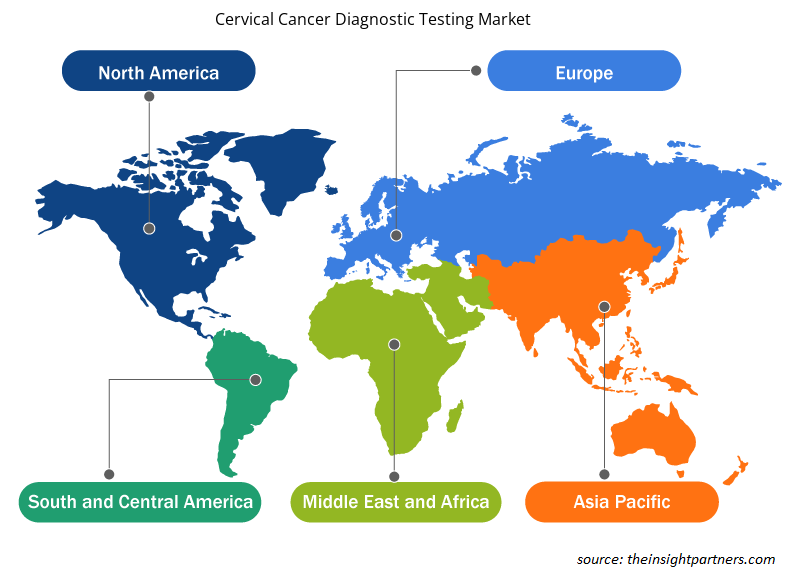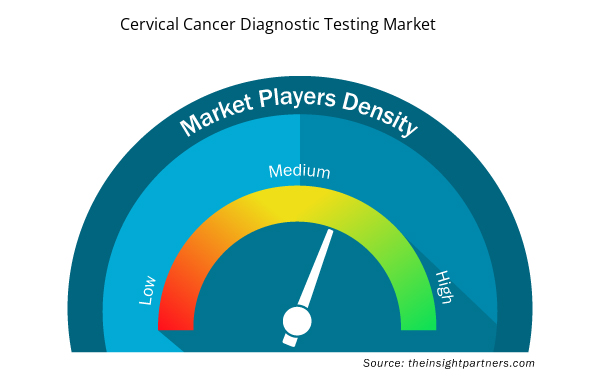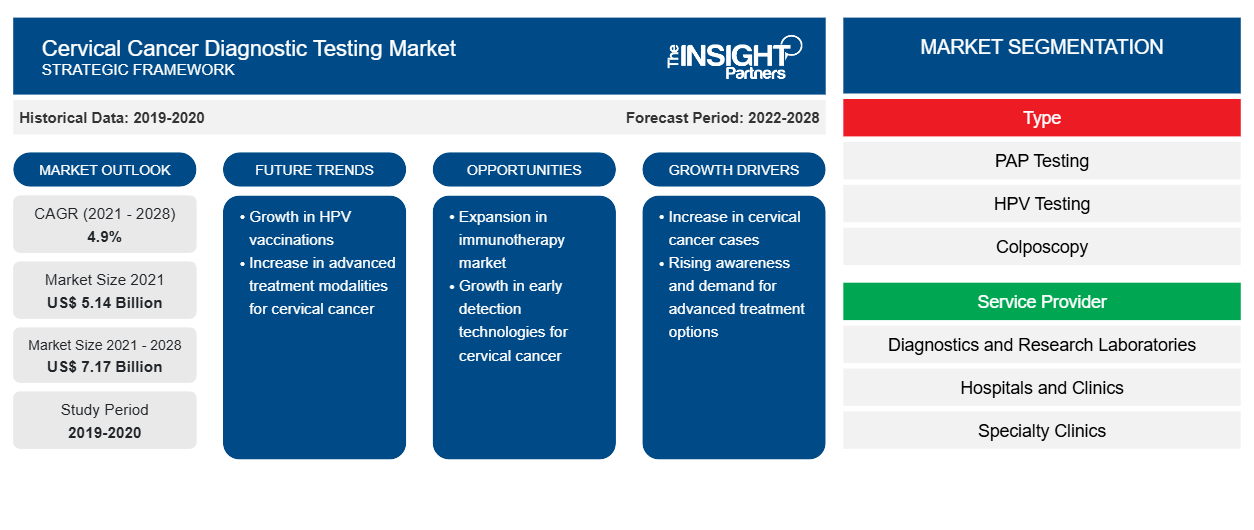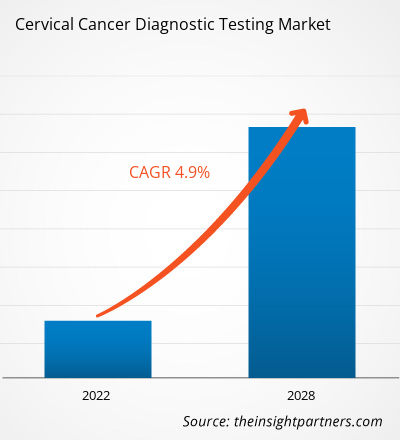Si prevede che il mercato dei test diagnostici per il cancro cervicale raggiungerà i 7.165,92 milioni di dollari entro il 2028, rispetto ai 5.141,25 milioni di dollari del 2021; si prevede una crescita a un CAGR del 4,9% dal 2021 al 2028.
Il cancro cervicale ha un tasso di mortalità significativo (quasi il 50%), che può essere abbassato con la diagnosi precoce e la prevenzione. Le alterazioni precancerose offrono opportunità di prevenzione e trattamento perché la progressione della malattia è spesso ritardata. Tuttavia, a causa della mancanza di consapevolezza o di accesso ai servizi diagnostici, molti casi vengono rilevati in fasi successive della progressione della malattia. Il papillomavirus umano (HPV) è una causa primaria di cancro cervicale che si trasmette tipicamente attraverso i rapporti sessuali. Esistono oltre 100 ceppi di HPV, 13 dei quali sono ad alto rischio o cancerogeni. Il gene attivo, E6 o E7, determina se un ceppo di HPV è ad alto o basso rischio. E6 si lega a p53, causando la distruzione proteolitica. E7, d'altra parte, si lega al retinoblastoma; il legame sposta i fattori di trascrizione precedentemente attaccati, con conseguente arresto del ciclo cellulare e inibizione della regolazione dell'apoptosi. Il test HPV rileva il papillomavirus umano nelle cellule cervicali. Altri approcci di screening impiegati nelle aree a basse risorse dei paesi in via di sviluppo sono il test del DNA dell'HPV e l'ispezione visiva. Lo screening cervicale su base regolare aiuta nella diagnosi precoce del cancro cervicale, abbassando il tasso di mortalità per questa malattia. Ogni tre anni, a tutte le donne di età compresa tra 21 e 65 anni viene consigliato di sottoporsi a un Pap test e alle donne di età compresa tra 30 e 65 anni viene consigliato di sottoporsi sia a un Pap test che a un test dell'HPV. In termini di fatturato, questo tipo ha dominato il mercato dello screening del cancro cervicale nel 2021 e si prevede che continuerà a dominare durante il periodo di previsione.
Personalizza questo report in base alle tue esigenze
Riceverai la personalizzazione gratuita di qualsiasi report, comprese parti di questo report, o analisi a livello nazionale, pacchetto dati Excel, oltre a usufruire di grandi offerte e sconti per start-up e università
- Scopri le principali tendenze di mercato in questo rapporto.Questo campione GRATUITO includerà analisi di dati che spaziano dalle tendenze di mercato alle stime e alle previsioni.
Approfondimenti di mercato
L'aumento della prevalenza del cancro guiderà la crescita del mercato dei test diagnostici per il cancro cervicale durante il periodo di previsione
Il cancro è emerso come una delle principali cause di morte in tutto il mondo. Secondo l'Organizzazione mondiale della sanità (OMS), il cancro è stata la prima causa di morte nelle persone di età inferiore ai 70 anni in 183 paesi e la quarta causa di morte in 123 paesi in tutto il mondo nel 2019. Inoltre, secondo i dati pubblicati dall'OMS a marzo 2021, nel 2020 si sono verificati circa 10 milioni di decessi a causa di diversi tipi di cancro. La crescente incidenza del cancro cervicale tra le donne in tutto il mondo guida la crescita del mercato dei test diagnostici per il cancro cervicale . Secondo l'OMS, ogni anno vengono registrati più di 270.000 decessi di donne a causa del cancro cervicale. I tassi di mortalità per cancro cervicale sono maggiori nei paesi a basso reddito a causa della diagnosi tardiva della malattia. Si prevede che il mercato crescerà nei prossimi anni a causa della crescente accettazione dei test diagnostici per il cancro cervicale per la diagnosi precoce della malattia.
La crescente prevalenza del cancro ha creato un onere per i sistemi sanitari in tutto il mondo. Secondo l'Agenzia Internazionale per la Ricerca sul Cancro (IARC), si stima che il carico globale di nuovi casi di cancro raggiungerà circa 27,5 milioni entro il 2040, e la malattia sarà probabilmente causa di circa 163 milioni di decessi entro quell'anno. Fattori come cambiamenti nello stile di vita, fumo, riduzione dell'attività fisica e condizioni climatiche e di salute incerte porteranno a un carico di cancro ancora maggiore nel mondo negli anni a venire.
Informazioni basate sul tipo
In base al tipo, il mercato dei test diagnostici per il cancro cervicale è segmentato in test PAP, test HPV , colposcopia, biopsie cervicali, cistoscopia e altri. Nel 2021, il segmento dei test PAP ha detenuto la quota maggiore del mercato e si stima che registrerà il CAGR più elevato nel periodo 2021-2028.
Approfondimenti basati sul fornitore di servizi
In base al fornitore di servizi, il mercato è segmentato in laboratori di ricerca, diagnostica e di ricerca, ospedali e cliniche, cliniche specialistiche e servizi di assistenza domiciliare. Nel 2021, il segmento dei laboratori di diagnostica e di ricerca ha detenuto la quota maggiore del mercato e si prevede che registrerà il CAGR più elevato nel mercato durante il 2021-2028.
Le aziende che operano nel mercato dei test diagnostici del cancro cervicale stanno adottando varie strategie come innovazioni di prodotto, per soddisfare le mutevoli esigenze dei clienti in tutto il mondo e mantenere il proprio marchio nel mercato globale.
Mercato dei test diagnostici del cancro cervicale – Segmentazione
Il mercato dei test diagnostici per il cancro cervicale è segmentato in base al tipo e al fornitore di servizi. In base al tipo, il mercato è suddiviso in test PAP, test HPV, colposcopia, biopsie cervicali, cistoscopia e altri. In base al fornitore di servizi, il mercato è ulteriormente suddiviso in laboratori di diagnostica e ricerca, ospedali e cliniche, cliniche specialistiche e servizi di assistenza domiciliare.
In termini geografici, il mercato dei test diagnostici per il cancro cervicale è segmentato in Nord America (Stati Uniti, Canada e Messico), Europa (Francia, Germania, Italia, Regno Unito, Spagna e resto d'Europa), Asia Pacifico (Australia, Cina, India, Giappone, Corea del Sud e resto dell'APAC), Medio Oriente e Africa (Arabia Saudita, Sud Africa, Emirati Arabi Uniti e resto del MEA) e Sud e Centro America (Brasile, Argentina e resto dello SCAM).
Approfondimenti regionali sul mercato dei test diagnostici per il cancro cervicale
Le tendenze regionali e i fattori che influenzano il mercato dei test diagnostici per il cancro cervicale durante il periodo di previsione sono stati ampiamente spiegati dagli analisti di Insight Partners. Questa sezione discute anche i segmenti e la geografia del mercato dei test diagnostici per il cancro cervicale in Nord America, Europa, Asia Pacifico, Medio Oriente e Africa e America centrale e meridionale.

- Ottieni i dati specifici regionali per il mercato dei test diagnostici del cancro cervicale
Ambito del rapporto di mercato sui test diagnostici del cancro cervicale
| Attributo del report | Dettagli |
|---|---|
| Dimensioni del mercato nel 2021 | 5,14 miliardi di dollari USA |
| Dimensioni del mercato entro il 2028 | 7,17 miliardi di dollari USA |
| CAGR globale (2021 - 2028) | 4,9% |
| Dati storici | 2019-2020 |
| Periodo di previsione | 2022-2028 |
| Segmenti coperti | Per tipo
|
| Regioni e Paesi coperti | America del Nord
|
| Leader di mercato e profili aziendali chiave |
|
Densità degli attori del mercato dei test diagnostici per il cancro cervicale: comprendere il suo impatto sulle dinamiche aziendali
Il mercato dei test diagnostici per il cancro cervicale sta crescendo rapidamente, spinto dalla crescente domanda degli utenti finali dovuta a fattori quali l'evoluzione delle preferenze dei consumatori, i progressi tecnologici e una maggiore consapevolezza dei benefici del prodotto. Con l'aumento della domanda, le aziende stanno ampliando le loro offerte, innovando per soddisfare le esigenze dei consumatori e capitalizzando sulle tendenze emergenti, il che alimenta ulteriormente la crescita del mercato.
La densità degli operatori di mercato si riferisce alla distribuzione di aziende o società che operano in un particolare mercato o settore. Indica quanti concorrenti (operatori di mercato) sono presenti in un dato spazio di mercato in relazione alle sue dimensioni o al valore di mercato totale.
Le principali aziende che operano nel mercato dei test diagnostici per il cancro cervicale sono:
- F. HOFFMANN-LA ROCHE LTD.
- Abate
- Diagnostica di ricerca incorporata
- QIAGEN
- Azienda
Disclaimer : le aziende elencate sopra non sono classificate secondo un ordine particolare.

- Ottieni una panoramica dei principali attori del mercato dei test diagnostici del cancro cervicale
Profili aziendali
- Società anonima F. Hoffmann-La Roche Ltd.
- Abate
- Diagnostica di ricerca incorporata
- QIAGEN
- Azienda
- Società farmaceutica DYSIS Inc.
- Società anonima
- Terapie guidate, Inc.
- Società Cooper, Inc.
- BD
- Analisi storica (2 anni), anno base, previsione (7 anni) con CAGR
- Analisi PEST e SWOT
- Valore/volume delle dimensioni del mercato - Globale, regionale, nazionale
- Industria e panorama competitivo
- Set di dati Excel



Report Coverage
Revenue forecast, Company Analysis, Industry landscape, Growth factors, and Trends

Segment Covered
This text is related
to segments covered.

Regional Scope
North America, Europe, Asia Pacific, Middle East & Africa, South & Central America

Country Scope
This text is related
to country scope.
Domande frequenti
Asia Pacific is registered as the fastest-growing region in the global cervical cancer diagnostic testing market. The market is this region is expected to grow significantly in countries such as China, Japan, and India. The market is driven by the increasing prevalence of cervical cancer in developing countries, including China, India, Malaysia, Japan, South Korea, and Australia.
The cervical cancer diagnostic testing market based on type is segmented into PAP testing, HPV testing, colposcopy, cervical biopsies, cystoscopy, others. In 2021, the PAP Testing segment accounted for the highest share. Besides, the HPV testing segment is expected to grow at a CAGR of 5.5% in the forecast period.
The global cervical cancer diagnostic testing market is segmented into North America, Europe, Asia Pacific, Middle East & Africa, and South & Central America. The North American area holds the largest market for aesthetic skin devices. The United States held the most significant cervical cancer diagnostic testing market and is expected to grow due to factors such as high awareness about disease prevention among women in the region, as well as to the many initiatives launched to prevent cervical cancer, which have increased the reach of insurance coverage for cervical screening tests, especially for low-income women, and others.
The cervical cancer diagnostic testing market majorly consists of the players such as as F. Hoffmann-La Roche Ltd., Abbott, Quest Diagnostics Incorporated, QIAGEN, Hologic, Inc., DYSIS Medical Inc., Femasys Inc., Guided Therapeutics, Inc, Cooper Companies, Inc., BD are amongst others.
Cervical Cancer refers to cancer that occurs in the cells of the cervix i.e. the lower part of the uterus that connects to the vagina. In 90% of the cases, cervical malignancies occur due to the HPV infection and are diagnosed through smear screening.
The factors that are driving and restraining factors that will affect the cervical cancer diagnostic testing market in the coming years. Factors such as the increasing prevalence of cancer and the rise in HPV infections are driving the market growth. However, less number of commercially available vaccines for the treatment of cancer are likely to hamper the growth of the market.
Trends and growth analysis reports related to Life Sciences : READ MORE..
The List of Companies - Cervical Cancer Diagnostic Testing Market
- F. HOFFMANN-LA ROCHE LTD.
- Abbott
- Quest Diagnostics Incorporated
- QIAGEN
- Hologic, Inc.
- DYSIS Medical Inc
- Femasys Inc.
- GUIDED THERAPEUTICS, INC
- Cooper Companies, Inc.
- BD
The Insight Partners performs research in 4 major stages: Data Collection & Secondary Research, Primary Research, Data Analysis and Data Triangulation & Final Review.
- Data Collection and Secondary Research:
As a market research and consulting firm operating from a decade, we have published and advised several client across the globe. First step for any study will start with an assessment of currently available data and insights from existing reports. Further, historical and current market information is collected from Investor Presentations, Annual Reports, SEC Filings, etc., and other information related to company’s performance and market positioning are gathered from Paid Databases (Factiva, Hoovers, and Reuters) and various other publications available in public domain.
Several associations trade associates, technical forums, institutes, societies and organization are accessed to gain technical as well as market related insights through their publications such as research papers, blogs and press releases related to the studies are referred to get cues about the market. Further, white papers, journals, magazines, and other news articles published in last 3 years are scrutinized and analyzed to understand the current market trends.
- Primary Research:
The primarily interview analysis comprise of data obtained from industry participants interview and answers to survey questions gathered by in-house primary team.
For primary research, interviews are conducted with industry experts/CEOs/Marketing Managers/VPs/Subject Matter Experts from both demand and supply side to get a 360-degree view of the market. The primary team conducts several interviews based on the complexity of the markets to understand the various market trends and dynamics which makes research more credible and precise.
A typical research interview fulfils the following functions:
- Provides first-hand information on the market size, market trends, growth trends, competitive landscape, and outlook
- Validates and strengthens in-house secondary research findings
- Develops the analysis team’s expertise and market understanding
Primary research involves email interactions and telephone interviews for each market, category, segment, and sub-segment across geographies. The participants who typically take part in such a process include, but are not limited to:
- Industry participants: VPs, business development managers, market intelligence managers and national sales managers
- Outside experts: Valuation experts, research analysts and key opinion leaders specializing in the electronics and semiconductor industry.
Below is the breakup of our primary respondents by company, designation, and region:

Once we receive the confirmation from primary research sources or primary respondents, we finalize the base year market estimation and forecast the data as per the macroeconomic and microeconomic factors assessed during data collection.
- Data Analysis:
Once data is validated through both secondary as well as primary respondents, we finalize the market estimations by hypothesis formulation and factor analysis at regional and country level.
- Macro-Economic Factor Analysis:
We analyse macroeconomic indicators such the gross domestic product (GDP), increase in the demand for goods and services across industries, technological advancement, regional economic growth, governmental policies, the influence of COVID-19, PEST analysis, and other aspects. This analysis aids in setting benchmarks for various nations/regions and approximating market splits. Additionally, the general trend of the aforementioned components aid in determining the market's development possibilities.
- Country Level Data:
Various factors that are especially aligned to the country are taken into account to determine the market size for a certain area and country, including the presence of vendors, such as headquarters and offices, the country's GDP, demand patterns, and industry growth. To comprehend the market dynamics for the nation, a number of growth variables, inhibitors, application areas, and current market trends are researched. The aforementioned elements aid in determining the country's overall market's growth potential.
- Company Profile:
The “Table of Contents” is formulated by listing and analyzing more than 25 - 30 companies operating in the market ecosystem across geographies. However, we profile only 10 companies as a standard practice in our syndicate reports. These 10 companies comprise leading, emerging, and regional players. Nonetheless, our analysis is not restricted to the 10 listed companies, we also analyze other companies present in the market to develop a holistic view and understand the prevailing trends. The “Company Profiles” section in the report covers key facts, business description, products & services, financial information, SWOT analysis, and key developments. The financial information presented is extracted from the annual reports and official documents of the publicly listed companies. Upon collecting the information for the sections of respective companies, we verify them via various primary sources and then compile the data in respective company profiles. The company level information helps us in deriving the base number as well as in forecasting the market size.
- Developing Base Number:
Aggregation of sales statistics (2020-2022) and macro-economic factor, and other secondary and primary research insights are utilized to arrive at base number and related market shares for 2022. The data gaps are identified in this step and relevant market data is analyzed, collected from paid primary interviews or databases. On finalizing the base year market size, forecasts are developed on the basis of macro-economic, industry and market growth factors and company level analysis.
- Data Triangulation and Final Review:
The market findings and base year market size calculations are validated from supply as well as demand side. Demand side validations are based on macro-economic factor analysis and benchmarks for respective regions and countries. In case of supply side validations, revenues of major companies are estimated (in case not available) based on industry benchmark, approximate number of employees, product portfolio, and primary interviews revenues are gathered. Further revenue from target product/service segment is assessed to avoid overshooting of market statistics. In case of heavy deviations between supply and demand side values, all thes steps are repeated to achieve synchronization.
We follow an iterative model, wherein we share our research findings with Subject Matter Experts (SME’s) and Key Opinion Leaders (KOLs) until consensus view of the market is not formulated – this model negates any drastic deviation in the opinions of experts. Only validated and universally acceptable research findings are quoted in our reports.
We have important check points that we use to validate our research findings – which we call – data triangulation, where we validate the information, we generate from secondary sources with primary interviews and then we re-validate with our internal data bases and Subject matter experts. This comprehensive model enables us to deliver high quality, reliable data in shortest possible time.


 Ottieni un campione gratuito per questo repot
Ottieni un campione gratuito per questo repot